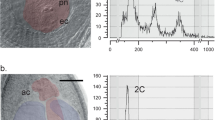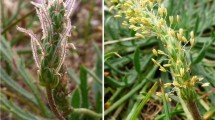Abstract
The potential for sexual reproduction in the facultative apomictHieracium pilosella was determined by pollinating with the closely related but morphologically distinctH. aurantiacum. The hybrid characteristics of the sexually produced progeny were used as markers for sex. Crossing was carried out under a range of environmental treatments to test the influence of (1) field versus glasshouse conditions, (2) nutrient level and the presence of a pathogen, and (3) photoperiod on the frequency of sex in facultative apomicticH. pilosella.
We found significantly more sexual reproduction in the glasshouse than in the field for the two populations tested, but no influence of nutrient level, presence of the pathogen, or individual genotype. Photoperiod was not a significant factor for the single population tested. In several of the experiments seed production was significantly different between the treatments, despite the absence of an effect on the frequency of sex, indicating greater plasticity in this trait.
In all three experiments a positive association was found between fecundity and the frequency of sex, with crosses producing sexual progeny having significantly more offspring than those that produced progeny exclusively via apomixis. We hypothesise that the cost of sex in this species may be offset by an increase in fecundity, with the cost of meiosis “diluted” by an increase in total progeny production.
Similar content being viewed by others
References
Anderson R.M. &May R.M. (1986): The invasion, persistence and spread of infectious diseases within animal and plant communities.Philos. Trans., Ser. B 314: 533–570.
Anscombe F.J. (1948): The transformation of Poisson, binomial and negative-binomial data.Biometrika 35: 246–254.
Bell G. (1982):The masterpiece of nature: the evolution and genetics of sexuality. Croom Helm, London.
Bicknell R.A. (1994): Micropropagation ofHieracium aurantiacum.Pl. Cell. Tissue Organ. Cult. 37: 197–199.
Bicknell R.A. &Borst N.K. (1994):Agrobacterium-mediated transformation ofHieracium aurantiacum.Int. J. Pl. Sci. 155: 467–470.
Bicknell R.A., Borst N.K. &Koltunow A.M. (2000): Monogeni c inheritance of apomixis in twoHieracium species with distinct developmental mechanisms.Heredity 84: 228–237.
Bicknell R.A., Lambie S.C. &Butler C. (2003): Quantification of progeny classes in two facultatively apomictic accessions ofHieracium.Hereditas 138: 11–20.
Bierzychudek P. (1989): Environmental sensitivity of sexual and apomicticAntennaria: do apomicts have general purpose genotypes?Evolution 43: 1456–1466.
Boswell C.C. &Espie P.R. (1998): Uptake of moisture and nutrients byHieracium pilosella and effects on soil in a dry sub-humid grassland.New Zealand J. Agric. Res. 41: 251–261.
Burton G.W. (1982): Effect of environment on apomixis in bahiagrass.Crop. Sci. 22: 109–111.
Ceplitis A. (2001): Genetic and environmental factors affecting reproductive variation inAllium vineale.J. Evol. Biol. 14: 721–730.
Chapman H.M. &Bicknell R.A. (2000): Recovery of a sexual and an apomictic hybrid from crosses between facultative apomictsH. caespitosum andH. praealtum.New Zealand J. Ecol. 24: 81–85.
Chapman H.M., Houliston G.J., Robson B., &Iline I. (2003): A case of reversal — the evolution and maintenance of obligate sexuals from facultative apomicts in an invasive weed.Int. J. Pl. Sci. 164: 719–728.
de Kovel C.G.F. &de Jong G. (1999): Responses of sexual and apomictic genotypes ofTaraxacum officinale to variation in light.Pl. Biol. 1: 541–546.
de Kovel C.G.F. &de Jong G. (2000): Selection on apomictic lineages ofTaraxacum at establishment in a mixed sexual-apomictic population.J. Evol. Biol. 13: 561–568.
Dunbrack R.L., Coffin C. &Howe R. (1995): The cost of males and the paradox of sex: an experimental investigation of the short-term competitive advantages of evolution in sexual populations.Proc. Roy. Soc. London, Ser. B, Biol. Sci. 262: 45–49.
Evans L.T. &Knox R.B. (1969): Environmental control of reproduction inThemeda australis.Austral. J. Bot. 17: 375–389.
Fan J. &Harris W. (1996): Effects of soil fertility level and cutting frequency on interference amongHieracium pilosella, H. praealtum, Rumex acetosella, andFestuca novae-zelandiae.New Zealand J. Agric. Res. 39: 1–32.
Gadella T.W.J. (1991): Reproduction, variation and interspecific hybridisation in three species ofHieracium sectionPilosellina (Compositae).Polish Bot. Stud. 2: 85–103.
Gounaris E.K., Sherwood R.T., Gounaris I., Hamilton R.H. &Gustine D.L. (1991): Inorganic salts modify embryo sac development in sexual and aposporousCenchrus ciliaris.Sexual Pl. Reprod. 4: 188–192.
Houliston G.J. &Chapman H.M. (2001): Sexual reproduction in field populations of the facultative apomict,Hieracium pilosella.New Zealand J. Bot. 39: 141–149.
Houliston G.J. &Chapman H.M. (2004): Reproductive strategy and population variability in the facultative apomictHieracium pilosella (Asteraceae).Amer. J. Bot. 91: 37–44.
Howard R.S. &Lively C.M. (1994): Parasitism, mutation accumulation and the maintenance of sex.Nature 367: 554–557.
Howell D.C. (1992):Statistical methods for psychology. Ed. 3. Duxbury Press, California.
Jenkins T.A. (1992): A review of characteristics of mouse-ear hawkweed (Hieracium pilosella).New Zealand Ecol. Soc. Occas. Publ. 2: 15–23.
Jenkins T.A. (1995):Fungal biological control of Hieracium. PhD Diss., University of Canterbury, Christchurch.
Knox R.B. (1967): Apomixis: seasonal and population differences in a grass.Science 157: 325–326.
Knox R.B. &Heslop-Harrison J. (1963): Experimental control of aposporous apomixis in a grass of theAndropogoneae.Bot. Not. 116: 127–141.
Koltunow A.M., Johnson S.D. &Bicknell R.A. (2000): Apomixis is not conserved in related, genetically characterisedHieracium plants of varying ploidy.Sexual Pl. Reprod. 12: 253–266.
Krahulcová A. &Krahulec F. (1999): Chromosome numbers and reproductive systems in selected representatives ofHieracium subgen.Pilosella in the Krkonoše Mts. (the Sudeten Mts).Preslia 71: 217–234.
Krahulcová A., Papoušková S. &Krahulec F. (2004): Reproduction mode in the allopolyploid facultatively apomictic hawkweedHieracium rubrum (Asteraceae, H. subgen.Pilosella).Hereditas 141: 19–30.
Levin D.A. (1975): Pest pressure and recombination systems in plants.Amer. Naturalist 109: 437–451.
Lively C.M. (1992): Parthenogenesis in a freshwater snail: reproductive assurance versus parasitic release.Evolution 46: 907–913.
Lively C.M. (1996): Host-parasite coevolution and sex.Bioscience 46: 107–114.
Lively C.M. &Howard R.S. (1994): Selection by parasites for clonal diversity and mixed mating.Philos. Trans., Ser. B 346: 271–281.
McWilliam J.R., Shanker K. &Knox R.B. (1970): Effects of temperature and photoperiod on growth and reproductive development inHyparrhenia hirta.Austral. J. Agric. Res. 21: 557–569.
Makepeace W. (1985): Growth, reproduction, and production biology of mouse-ear and king devil hawkweed in eastern South Island, New Zealand.New Zealand J. Bot. 23: 65–78.
May R.M. &Anderson R.M. (1983): Epidemiology and genetics in the coevolution of parasites and host.Proc. Roy. Soc. London, Ser. B, Biol. Sci. 219: 281–313.
Michaels H.J. &Bazzaz F.A. (1989): Individual and population responses of sexual and apomictic plants to environmental gradients.Amer. Naturalist 134: 190–207.
Nygren A. (1951): Form and biotype formation inCalamagrostis purpurea.Hereditas 37: 519–532.
O’Connell L.M. &Eckert C.G. (2001): Differentiation in reproductive strategy between sexual and asexual populations ofAntennaria parlinii.Evol. Ecol. Res. 3: 311–330.
Peck J.R. &Waxman D. (2000): What’s wrong with a little sex?J. Evol. Biol. 13: 63–69.
Ridley M. (1993):The Red Queen: sex and the evolution of human nature. Viking, London.
Scott D. (1993): Response ofHieracium in two long term manipulative agricultural trials.New Zealand J. Ecol. 17: 41–46.
Scott D. (2000a): Fertiliser and grazing rejuvenation of fescue tussock grassland.New Zealand J. Agric. Res. 43: 481–490.
Scott D. (2000b): Sustainability of New Zealand high-country pastures under contrasting development inputs. 6. fertiliser efficiency.New Zealand J. Agric. Res. 43: 525–532.
Scott D., Robertson J.S. &Archie W.J. (1990): Plant dynamics of New Zealand tussock grassland infested withHieracium pilosella. I. effects of seasonal grazing, fertilizer and overdrilling.J. Appl. Ecol. 27: 224–234.
Stace C. (1997):New flora of the British Isles, second edition. Cambridge University Press, Cambridge.
Templeton A.R. (1982): The prophecies of parthenogenesis. In:Dingle H. &Hegmann J.P. (eds.),Evolution and genetics of life histories, Springer Verlag, New York, pp. 75–101.
Yeung E.C. (1989): Hieracium.CRC handbook of flowering 6. CRC Press, Boca Raton.
Zar J.H. (1996):Biostatistical analysis. Ed. 3. Prentice-Hall, Upper Saddle River.
Author information
Authors and Affiliations
Corresponding author
Rights and permissions
About this article
Cite this article
Houliston, G.J., Chapman, H.M. & Bicknell, R.A. The influence of genotype and environment on the fecundity and facultative expression of apomixis inHieracium pilosella . Folia Geobot 41, 165–181 (2006). https://doi.org/10.1007/BF02806477
Received:
Revised:
Accepted:
Issue Date:
DOI: https://doi.org/10.1007/BF02806477




